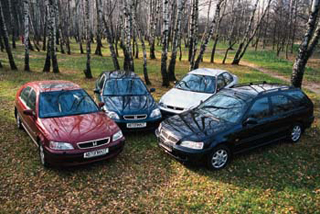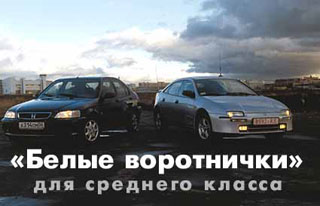Test drive Honda Civic Sedan 1995 - 2000 sedan
Portrait on the background of rivals
Everything is known in comparison ... Guided by this, we went to the auto polygon in order to meticulously compare the most-most domestic vehicle VAZ 21103 with its foreign classmates.In preparation for this test, a surprise awaited us. It turns out that there are not so many real classmates for one hundred and thirds, and the reason is that one and a half liters (let it seem strange) a rather rare engine volume. Most European and Japanese manufacturers make motors 1.4 and 1.6 liters. Only 1.5-liter are common in Korea, which is associated with the existing tax system.
We get acquainted with competitors
 All VAZ 21103 classmates presented in our test are sedans and all under the hoods of 1.5-liter 16-valve engines with distributed gasoline injection. It is curious that foreigners are slightly larger than tens-50-170 mm longer and 15-31 mm wider, in addition, they have a wider track (an average of 100 mm) and a long wheelbase (in Honda it is already 128 mm more. than VAZ 21103).
All VAZ 21103 classmates presented in our test are sedans and all under the hoods of 1.5-liter 16-valve engines with distributed gasoline injection. It is curious that foreigners are slightly larger than tens-50-170 mm longer and 15-31 mm wider, in addition, they have a wider track (an average of 100 mm) and a long wheelbase (in Honda it is already 128 mm more. than VAZ 21103). Kia Sephia II has been produced since 1998, the BFD family engine - the power unit of the former Mazda -323 with two camshafts (a gear drive) and an adjustable catalytic neutralizer. The degree of compression is 9.3.
Mazda 323 has been produced since 1998, the modernized engine has a cylinder block similar to KIA, is equipped with a regulated catalytic neutralizer. The degree of compression is 9.4.
Honda Sivik in production since 1995, an engine with one distribution shaft (a gear-shaped drive), is equipped with a V-TEC valve lifting control system and an adjustable neutralizer located immediately behind the exhaust manifold. The degree of compression is 9.6.
VAZ 21103 in the series since 1998, the VAZ 2112 engine with two camshafts (a gear drive), without a catalytic neutralizer. The degree of compression is 10.5.
Taste, for color ...
 None of these cars can be called non -modern, but this is perhaps the only thing that can be considered common in their appearance. With its calm, rounded forms of Sephy II, it is not at all like a venue, balancing on the verge of angularity, and a clear wedge -shaped silhouette of a Sivik with a low sloping hood and outstanding wheel arches is hardly close to both of them. Mazda’s most controversial design, the other two foreign cars make a positive impression. Against such a background, one hundred and third resembles a miniature submarine thrown to land: a massive barrel -shaped case with a small glass cut, a wide rounded sidewall, in deep dark cuts of wings - wheels with almost deaf disks. The most diplomatic definition for her appearance is an original avant -garde.
None of these cars can be called non -modern, but this is perhaps the only thing that can be considered common in their appearance. With its calm, rounded forms of Sephy II, it is not at all like a venue, balancing on the verge of angularity, and a clear wedge -shaped silhouette of a Sivik with a low sloping hood and outstanding wheel arches is hardly close to both of them. Mazda’s most controversial design, the other two foreign cars make a positive impression. Against such a background, one hundred and third resembles a miniature submarine thrown to land: a massive barrel -shaped case with a small glass cut, a wide rounded sidewall, in deep dark cuts of wings - wheels with almost deaf disks. The most diplomatic definition for her appearance is an original avant -garde. What is inside?
 No, wait, we will get to the characteristics of the engines, and first we will examine the machines salons in detail. Here, just like outside, not everything is simple, in any case, what eyes see is not always consistent with what the landing mannequin says. At first glance, Mazda’s most spacious salon, which, in general, is true. However, the spacious does not mean wide: Sephia leads by a noticeable margin, followed by VAZ 21103, the narrowest is Sivic. Not too broad -shouldered passengers can easily be able to sit in the back seat in all cars, but ... in the top ten, the extreme will have to support the head of the body with the head: in the upper part, the cabin is very narrow in the upper part. The right front chair of the Mazda is equipped with an additional hinge, which allows you to throw the back forward, turning it into a table - a rare, but convenient solution. However, it is more important to us how good it is for the one who is driving.
No, wait, we will get to the characteristics of the engines, and first we will examine the machines salons in detail. Here, just like outside, not everything is simple, in any case, what eyes see is not always consistent with what the landing mannequin says. At first glance, Mazda’s most spacious salon, which, in general, is true. However, the spacious does not mean wide: Sephia leads by a noticeable margin, followed by VAZ 21103, the narrowest is Sivic. Not too broad -shouldered passengers can easily be able to sit in the back seat in all cars, but ... in the top ten, the extreme will have to support the head of the body with the head: in the upper part, the cabin is very narrow in the upper part. The right front chair of the Mazda is equipped with an additional hinge, which allows you to throw the back forward, turning it into a table - a rare, but convenient solution. However, it is more important to us how good it is for the one who is driving. Everything is simple and understandable here: the driver’s workplace in foreigners is almost the same, only the seats differ. The best in shape - in Mazda, a little worse back at Kia, the Honda chair - an example of how to do it: the pillow is short, too soft and absolutely horizontal. Even a successful back design is not able to change the impression. But the one hundred and third in this part is all right, but ... the course of the longitudinal adjustment of the seat is too small, and the driver tall above 185 cm tall
Would be hollow, but there would be a woodpecker
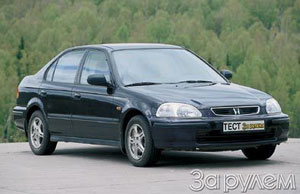 It seems that small trunk in the sedans have sunk into oblivion forever. Who from our four, you look at the hollow - what is needed. The rear seat, of course, develops in parts, which means that you can still increase the volume of the cargo compartment. Perhaps, only Sephia is not entitled to highly brag about the capacity of its trunk. But this can do one hundred and third - she has no equal. That's just the loading height (the distance from the lower edge of the baggage compartment to the asphalt) is the largest, and it is necessary to load the hold from above, which is not very convenient when things are large and heavy. However, Kia is not without sin: its luxurious rear lights limit the width of the opening, and the trunk lock poses a clear threat to the back of the head. The designers enclosed it in the plastic case and provided him with a warning inscription, but it is usually possible to see it only in a tenth of a second before the back of the head with the lock. The consequences of such a meeting in the press are usually not commented by non -normative vocabulary. But there are simply no complaints about Honda and Mazda.
It seems that small trunk in the sedans have sunk into oblivion forever. Who from our four, you look at the hollow - what is needed. The rear seat, of course, develops in parts, which means that you can still increase the volume of the cargo compartment. Perhaps, only Sephia is not entitled to highly brag about the capacity of its trunk. But this can do one hundred and third - she has no equal. That's just the loading height (the distance from the lower edge of the baggage compartment to the asphalt) is the largest, and it is necessary to load the hold from above, which is not very convenient when things are large and heavy. However, Kia is not without sin: its luxurious rear lights limit the width of the opening, and the trunk lock poses a clear threat to the back of the head. The designers enclosed it in the plastic case and provided him with a warning inscription, but it is usually possible to see it only in a tenth of a second before the back of the head with the lock. The consequences of such a meeting in the press are usually not commented by non -normative vocabulary. But there are simply no complaints about Honda and Mazda. Whose motor is better?
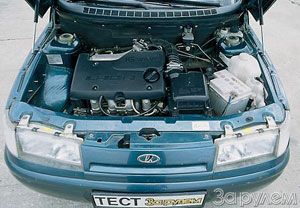 We did not aim to compare the engines in isolation from the cars themselves. After all, the driver judges by maximum speed and acceleration dynamics about the power of the motor and the torque. We did the same, understanding, of course, that the parameters of the transmission and the machine itself also play a significant role.
We did not aim to compare the engines in isolation from the cars themselves. After all, the driver judges by maximum speed and acceleration dynamics about the power of the motor and the torque. We did the same, understanding, of course, that the parameters of the transmission and the machine itself also play a significant role. The most powerful of the cars is Sivik, and we did not without reason expecting the highest results from him. This was partly confirmed: Honda became the leader in maximum speed and elasticity in the fourth gear. On the fifth, she missed the Mazda forward with her traction engine and short gears, which became the winner and in acceleration to 100 km/h. VAZ 21103 took third place in this discipline, but showing the only result that exceeds the factory data. Kia lost to the rivals in all nominations, despite the smooth, without failures and pickups, traction of the engine in the entire range.
It was pleasantly surprised that the maximum speed of one hundred and thirds measured at the landfill was only 3.5 km/h less than that of Honda, according to the passport with an impressive advantage - 20 liters. With.! This is undoubtedly
 a certificate of very good aerodynamics of the VAZ machine, which, incidentally, is confirmed by the longest fault. And if you take into account its considerable road clearance, which does not help a decrease in air resistance in comparison with foreigners, the results of the work of domestic aerodynamics can be called outstanding without false modesty.
a certificate of very good aerodynamics of the VAZ machine, which, incidentally, is confirmed by the longest fault. And if you take into account its considerable road clearance, which does not help a decrease in air resistance in comparison with foreigners, the results of the work of domestic aerodynamics can be called outstanding without false modesty. Honestly, the characteristics of the one hundred and thirds did not disappoint us. It was obvious that during its creation they sought to make an even engine capable of driving in and at the same time alive at high speeds. This would succeed, do not cross out all the efforts of the developers the main couple with a gear ratio of 3.706. The machine is extremely difficult to maximize speed, and the elasticity in the fifth gear leaves much to be desired - even a small rise requires switching. I would like to remind you that the enthusiasm of the designers with too long the main pairs has already created notorious fame to one domestic car ... So why not learn from other people's mistakes?
And one more thing: foreigners, without visible difficulties, take AI -92 gasoline, and our one hundred and third consumes it as a student vodka - drinks, but frowns. After a calm ride, it is worth stepping on the accelerator more difficult, as a characteristic chin-beard is heard from under the hood ... This is disappointing, but understandable-the VAZ 2112 engine has the highest degree of compression. Or do you just need to create a normal engine control program?
Where will the curve take out?
 Nimble acceleration is, of course, great, but how are the brakes? Honda and Mazda with ABS showed a magnificent slowdown: 9.6-9.7 m/s2, Kia without ABS looked somewhat worse, although it was quite acceptable-8.4-8.5 m/s2. The characteristics of the VAZ 21103, despite the ventilated front discs, were not at all at the height: 6.7-6.9 m/s2 when braking with 100 km/h. However, having some experience in testing brake pads, we can assume that the matter is not necessarily in the brake mechanisms. Perhaps it is worth playing with blocks?
Nimble acceleration is, of course, great, but how are the brakes? Honda and Mazda with ABS showed a magnificent slowdown: 9.6-9.7 m/s2, Kia without ABS looked somewhat worse, although it was quite acceptable-8.4-8.5 m/s2. The characteristics of the VAZ 21103, despite the ventilated front discs, were not at all at the height: 6.7-6.9 m/s2 when braking with 100 km/h. However, having some experience in testing brake pads, we can assume that the matter is not necessarily in the brake mechanisms. Perhaps it is worth playing with blocks? A little about the suspension. It is known that handling and comfort are bad neighbors, and any road car is an inevitable victim of a compromise. True, the latter is successful and not very ... Honda looks good about the first impressions - the car is confident on the road even at the limit of the adhesion properties of tires and at the same time very comfortable. But for the delicacy of the suspension, you have to pay its low energy intensity: it often triggers all the way. The direct opposite is Kia: here the suspension is the hardest, meticulously conveys small irregularities, but the car is obedient at any speed, reacts vividly to the steering wheel and does not ask to slow down too much before turning. In general, energy intensity is at a height: you have to try tightly so that the suspension stroke limits come into business. It seems that the most reasonable compromise is Mazda,
 but I don’t want to quickly pass the turns on it. And finally, the VAZ 21103. The smoothness of the move is even better than that of Honda, and the suspension jokingly swallows such pieces, from one species of which it becomes uneasy. Energy intensity is beyond praise. Is this really the ideal? Alas, you have to pay for a long -flowing and rather soft suspension the most delicate - controllability. Strong rolls in corners, delayed with sharp maneuvers, deep, sharp drifts, inaccurate steering wheel - all this does not decorate the car.
but I don’t want to quickly pass the turns on it. And finally, the VAZ 21103. The smoothness of the move is even better than that of Honda, and the suspension jokingly swallows such pieces, from one species of which it becomes uneasy. Energy intensity is beyond praise. Is this really the ideal? Alas, you have to pay for a long -flowing and rather soft suspension the most delicate - controllability. Strong rolls in corners, delayed with sharp maneuvers, deep, sharp drifts, inaccurate steering wheel - all this does not decorate the car. What is the end?
If we distract from what is called the quality of manufacture, VAZ 21103 looks quite worthy against the background of imported classmates. And the motor is also not bad. And yet, if it is unbiased to look at the car claiming the title of domestic Grand Turismo, one gets the impression that those who created it communicated very little to each other - from quite successful components it turned out to be far from the most worthy conglomerate. For real competition, additional equipment will be required: ABS, steering wheel, air conditioning. It is desirable that the assembly quality rises at least to the level of Uzbek Nexia. As for the shortcomings of the chassis, they are easily corrected. At least tuning companies are already taking up this. From one hundred and third, they will not be left without work.
SUMMARY
Kia Sephy II.
Do not occupy a character, although there is something to learn from others.
Mazda 323.
Sobviness, reliability and art of compromise.
Honda Sivik.
The song motor and the highest quality, not surpassed by other participants in the dough.
VAZ 21103.
Equal from contradictions, but perhaps they are permitted. We'll have to bend your legs a lot. And one more thing: the left leg of even a modest 43rd size constantly clings to the lower edge of the front panel - not deadly, but unpleasant.



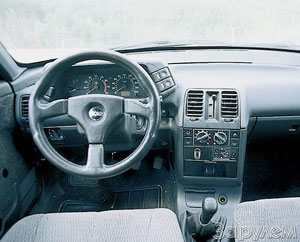








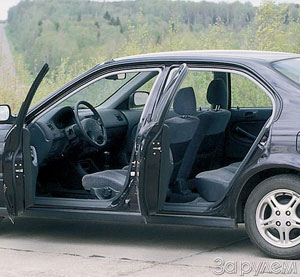
Anatoly Fomin. Photo by Sergey Ivanov
Source: The magazine "Driving"
Honda Civic Sedan 1995 test drives - 2000
Honda Civic Crash Test Sedan 1995 - 2000
Krassh Test: Detailed Information18%
Driver and passengers
3%
Pedestrians





